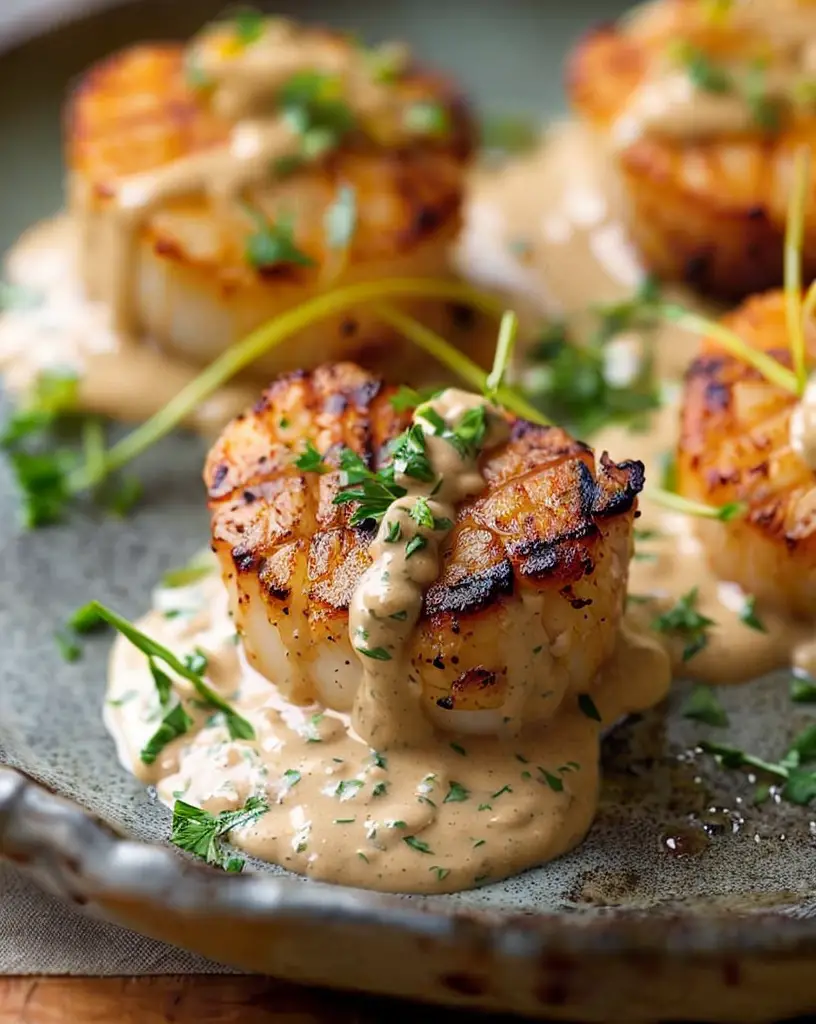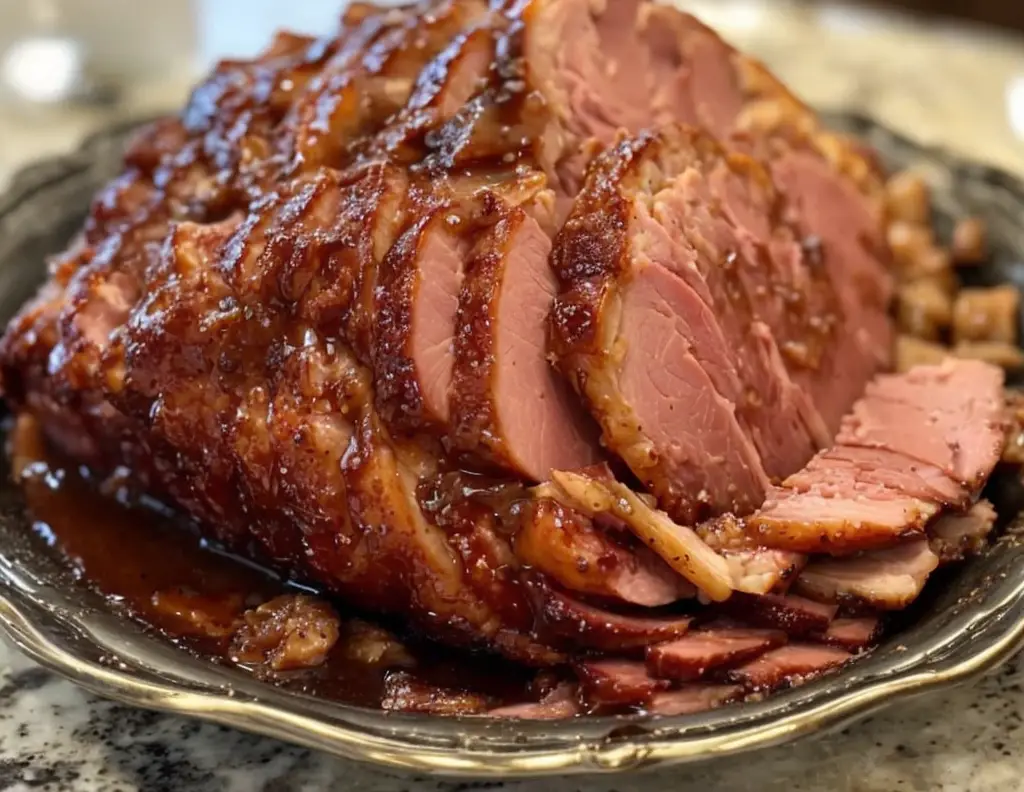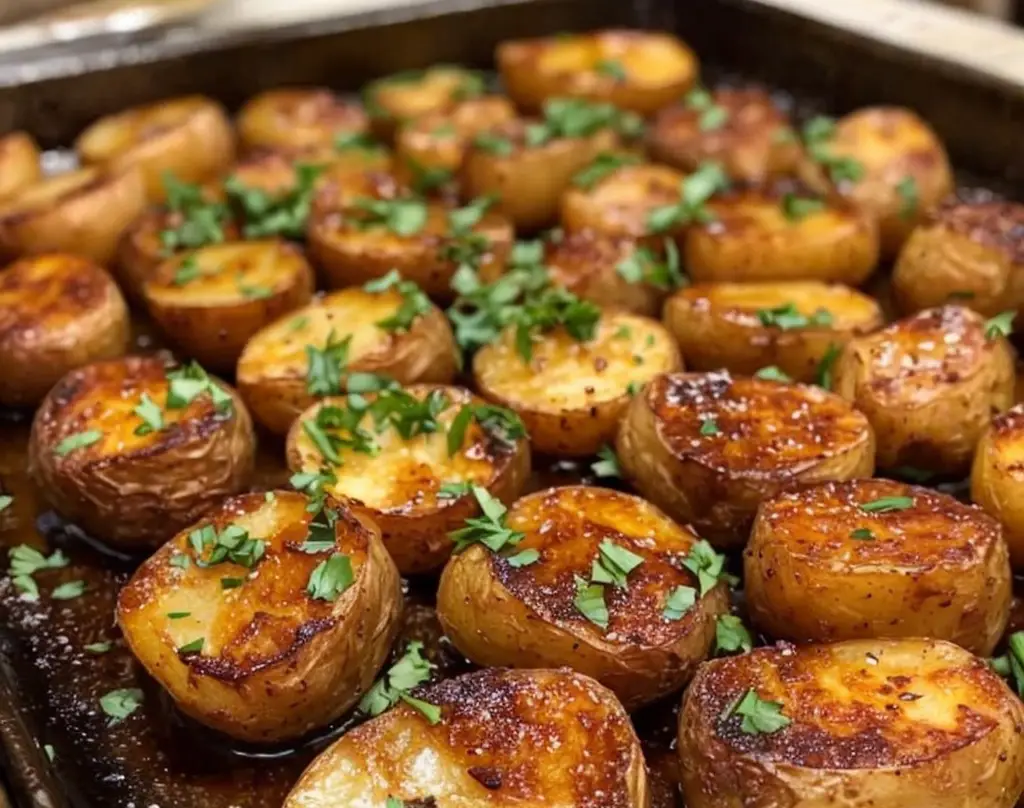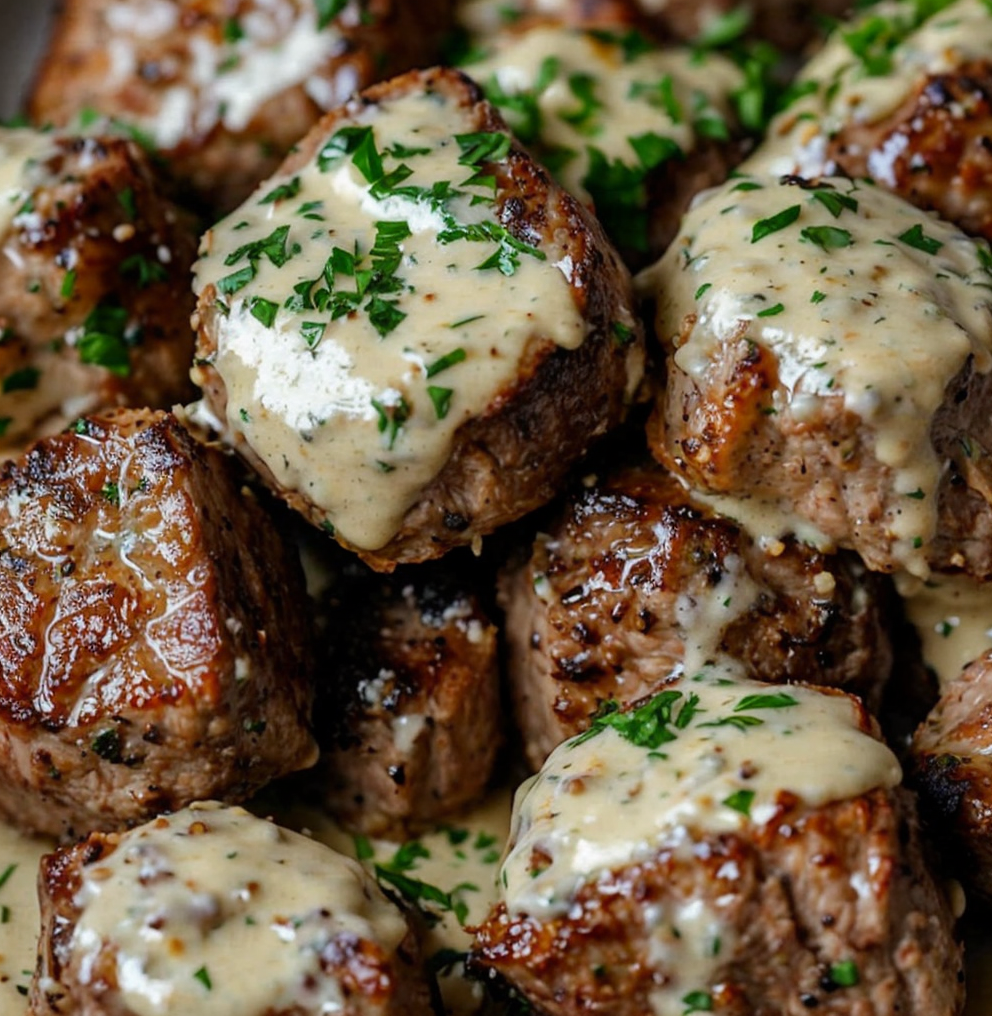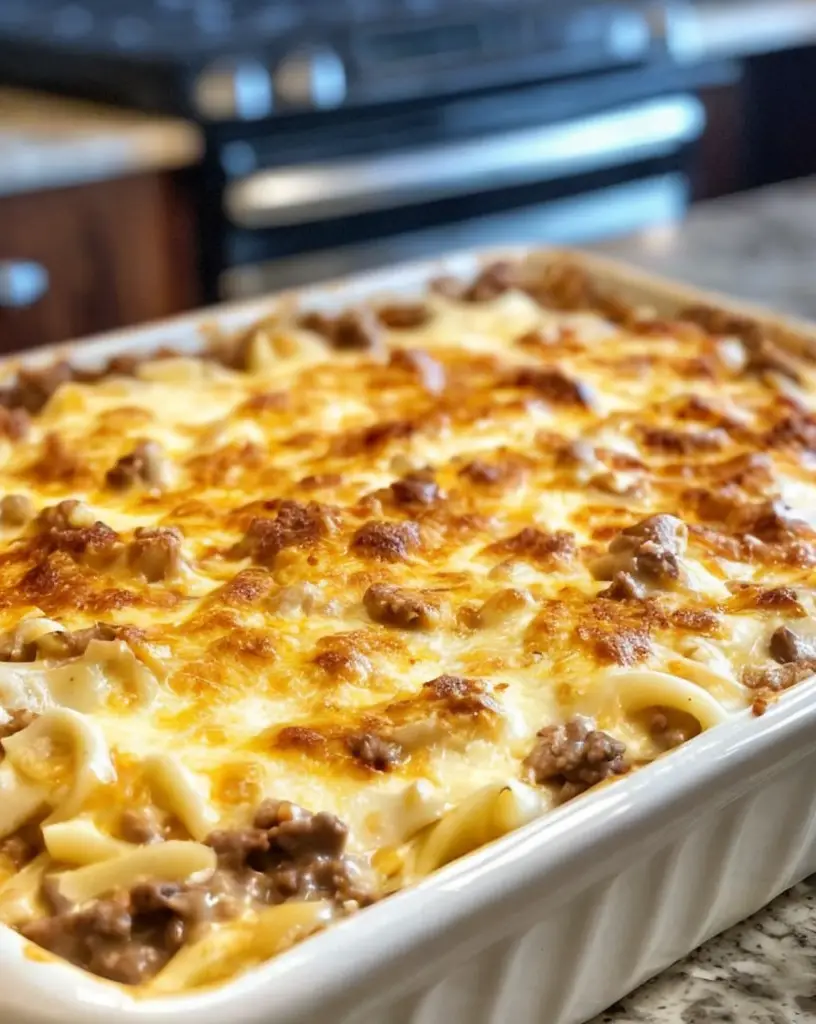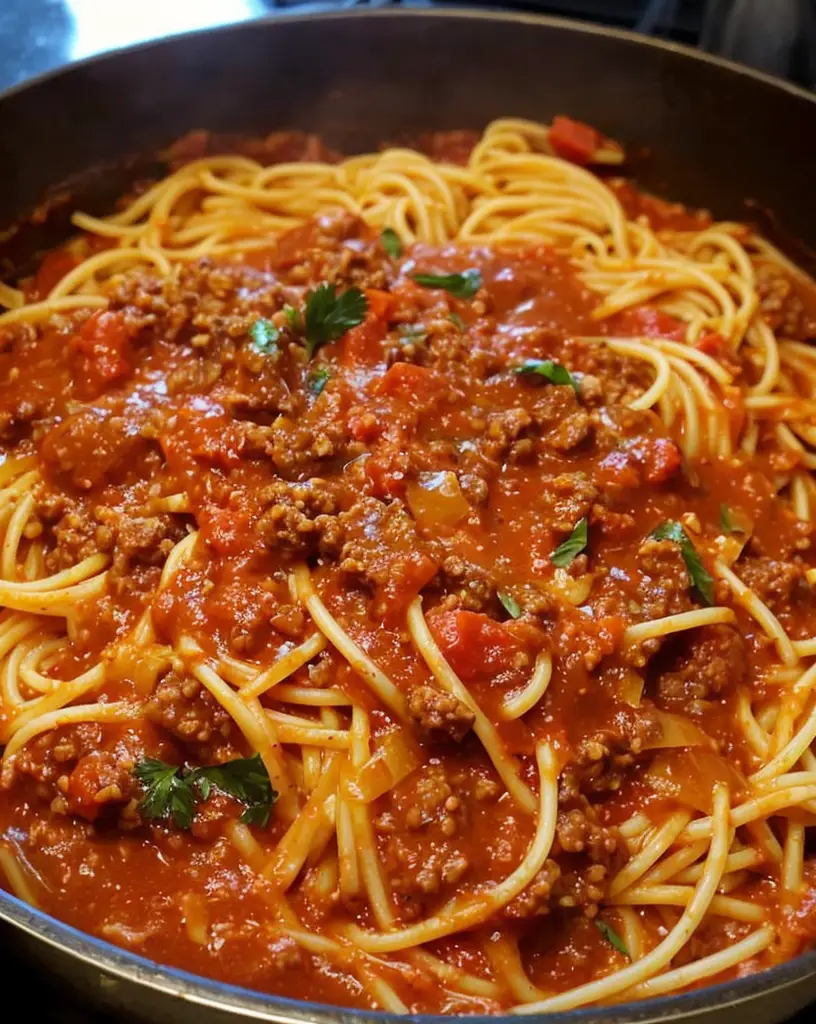Grilled Scallops with Rémoulade Sauce: A Seafood Delight
Experience the taste of the ocean with our delightful Grilled Scallops with Rémoulade Sauce. This recipe brings together the sweet and delicate flavors of scallops perfectly grilled, complemented by the tangy and zesty Rémoulade sauce. With just the right balance of spices, this dish will transport your taste buds to a coastal paradise, making it an ideal choice for a special dinner or a casual summer gathering.
Cooking scallops can be intimidating for some, yet this recipe is simple, highlighting the natural sweetness of the seafood. The Rémoulade sauce, with its creamy texture and robust flavor, adds an exciting punch that elevates the overall dining experience. Perfectly paired with fresh greens or roasted vegetables, Grilled Scallops are sure to impress both family and guests alike.
Quick Recipe Highlights
- Flavor Profile: Sweet scallops combined with a tangy, creamy sauce create a delightful contrast that tantalizes your palate.
- Texture: The scallops have a tender yet slightly charred exterior, while the Rémoulade offers a creamy, smooth mouthfeel.
- Aroma: The enticing aroma of grilled seafood mixed with fresh herbs and spices fills the air, making it hard to resist.
- Visual Appeal: Beautifully charred scallops arranged on a plate with a vibrant green sauce create a stunning presentation.
- Skill Level Needed: This recipe is perfect for novice to intermediate cooks looking to enhance their seafood preparation skills.
- Special Equipment: A grill (or grill pan) and skewers (if using) are recommended for optimal results.
Recipe Overview
- Difficulty Level: Medium, this recipe involves grilling which requires attention to timing and heat control.
- Category: Seafood main course, perfect for summer dinners or elegant gatherings.
- Cuisine: This dish reflects coastal and French influences, particularly with the use of Rémoulade sauce.
- Cost: Relatively moderate, scallops can be pricier but their superior taste justifies the expense.
- Season: Ideal during warmer months when seafood is freshest and outdoor cooking is most enjoyable.
- Occasion: Great for parties, fancy dinners, or romantic date nights.
Why You’ll Love This Recipe
This Grilled Scallops with Rémoulade Sauce is a taste sensation that will leave you craving more. The sweet flavor of the scallops, grilled to perfection, is beautifully complemented by the Rémoulade, making for a harmonious dish. Each bite showcases the natural sweetness of the seafood, alongside the zestiness of the sauce, creating an exquisite culinary experience. With a delectable texture that’s both tender and slightly crispy from the grill, this dish truly excites the senses.
What’s more, this recipe is extremely convenient to make. With a preparation time of just 15 minutes and a quick grilling process, you can have this sophisticated meal ready in no time. Ideal for eager home cooks, it allows for minimal fuss while delivering impressive results that are perfect for sharing with loved ones.
Not only is this dish delicious, but it also offers nutritional benefits. Scallops are an excellent source of lean protein, coupled with essential vitamins and minerals. They are low in calories and provide heart-healthy omega-3 fatty acids, making them a smart choice for anyone looking to eat healthily.
This recipe also shines during social gatherings, where its stunning presentation and delicious combination of flavors create a memorable experience. Serve it to impress your guests or bring it to potlucks—it’s sure to spark delightful conversations at the dinner table.
Cost-effective for the flavors you’re receiving, this dish stands as a testament to the idea that exquisite dining doesn’t have to break the bank. With the right technique, you’ll deliver a fine dining experience that is accessible to home cooks everywhere.
Historical Background and Cultural Significance
The origins of scallops date back thousands of years, tracing their roots to ancient coastal communities. Known for their natural sweetness, scallops have been a favorite among seafood lovers for centuries, celebrated in various cuisines around the world. The dishes served with scallops reflect the culinary diversity of coastal regions, highlighting local ingredients and preparation styles.
Rémoulade sauce has its origins in France, where it was initially served as a condiment for cold meats and fish. Over time, variations of the sauce spread across different cultures, often adapting to local tastes and ingredients. The sauce became synonymous with seafood dishes, providing a tangy balance to the delicate flavor of fish and shellfish.
This recipe showcases the meeting of two beloved culinary traditions, placing scallops at the forefront alongside a classic French sauce. As seafood becomes increasingly popular, both scallops and Rémoulade have become staples at both casual and upscale dining establishments, which speaks to their versatility and broad appeal.
Regional variations of this dish can be found in coastal areas around the world, each bringing unique local twists and flavor integrations reflective of their geography and culinary practices. Adaptations can include the use of different herbs in the Rémoulade or variations in how the scallops are cooked or accompanied.
Ingredient Deep Dive
Scallops: These shellfish are celebrated for their delicate sweetness and versatility in cooking. They are rich in protein, vitamins B12 and A, and minerals such as iron and magnesium. When selecting scallops, look for those that are firm, shiny, and have a slight ocean smell. Scallops should be stored in the refrigerator and used within one to two days for maximum freshness.
Options for substitution include sea scallops or bay scallops, with the former providing a larger size and meatier texture, making them ideal for grilling. If fresh scallops aren’t available, frozen scallops can be a suitable alternative, although fresh is generally recommended for optimal flavor.
Rémoulade Sauce: This classic sauce originated from a base of aioli and has evolved into a versatile condiment. It typically includes mayonnaise, mustard, capers, pickles, and herbs, giving it a bright and tangy flavor profile. Nutritionally, homemade Rémoulade can be made healthier by reducing oil or incorporating Greek yogurt. When preparing, be sure to taste and adjust seasoning to preference. Store in the refrigerator for up to a week, making it a convenient condiment for various dishes.
Substitutions can include using Greek yogurt as a base for a lighter version or swapping in different herbs to customize the flavor, tailoring the Rémoulade to suit your palate or the season.
Common Mistakes to Avoid
- Overcooking scallops: Scallops cook quickly; too much time on the grill will turn them rubbery.
- Not drying scallops: Ensure scallops are dry before grilling to achieve a great sear.
- Skipping preheating the grill: A hot grill is essential for getting that perfect char on the scallops.
- Using low-quality scallops: Fresh, high-quality scallops will make a noticeable difference in flavor.
- Neglecting seasoning: Properly seasoning both the scallops and the Rémoulade sauce enhances the dish’s flavor.
- Incorrect sauce storage: Rémoulade should be refrigerated immediately and used within a week.
- Not using skewers: If grilling smaller bay scallops, consider using skewers to prevent them from falling through the grill.
- Making Rémoulade too far in advance: Fresh herbs in the sauce may lose flavor over time, so prepare just before serving.
- Forgetting to taste: Always taste your sauce and scallops before serving to ensure seasoning is balanced.
- Using cold scallops: Let scallops sit at room temperature for a few minutes before cooking; this helps in even cooking.
Essential Techniques
Grilling: Grilling scallops perfectly is key to this dish. It’s important to use high heat to achieve that delicious char and to not overcrowd the grill. Mastering the grill will enhance the scallop’s flavors and create a delightful texture. Look for a golden brown crust as a visual cue for perfect timing.
Making Rémoulade: This technique is crucial for crafting the perfect sauce that complements the scallops. Start by mixing your base and adjusting flavors gradually. Tasting as you go will help achieve a balanced sauce. The key is to avoid over-mixing, as the sauce should retain some texture from the herbs and seasonings.
Pro Tips for Perfect Grilled Scallops with Rémoulade Sauce
1. Always start with dry scallops for that perfect sear; pat them dry with paper towels before cooking.
2. Use a high-quality grill for even heat distribution and optimal cooking.
3. For maximum flavor, marinate scallops for 30 minutes before grilling with olive oil and lemon juice.
4. Maintain grill temperature; ideal grilling temperature is around 400°F (200°C).
5. Let Rémoulade sit in the fridge for at least 30 minutes to allow flavors to meld before serving.
6. Pair scallops with seasonal vegetables to enhance their flavor profile and provide a balanced meal.
7. When serving, layer the sauce in the center of the plate and arrange scallops beautifully on top.
8. Use a meat thermometer to ensure scallops reach an internal temperature of 125°F (52°C) for optimal doneness.
Variations and Adaptations
For a regional twist, consider using local herbs or citrus in the Rémoulade, such as dill or grapefruit, to give it a distinctive flavor. Additionally, seasonal adaptations can include pairing grilled scallops with summer vegetables like zucchini or corn for a refreshing touch.
Dietary modifications can be made by using a vegan alternative for the Rémoulade or skipping the mayonnaise entirely in favor of a tahini-based sauce for a nutty flavor. Texture variations might involve serving the scallops over a bed of creamy polenta or risotto for a heartier dish.
Flavor variations can also opt for different marinades, such as a spicy remoulade using Sriracha or chili powder, giving the dish a kick. Presentation alternatives could include serving scallops on skewers for a fun, party-ready presentation.
Serving and Presentation Guide
When plating your grilled scallops, consider using a large, white plate to highlight the beautiful colors of the dish. A drizzle of the Rémoulade around the scallops not only enhances visual appeal but also adds flavor with every bite. For garnish, freshly chopped herbs or lemon zest can add a pop of color.
Pair your scallops with traditional accompaniments like a light salad or grilled vegetables, maintaining a focus on fresh ingredients. For modern serving suggestions, present the scallops on a wooden board for a rustic touch, or atop a bed of greens for a refreshing contrast.
Temperature considerations are essential; serve the dish immediately after cooking to ensure the scallops are warm and retain their tender texture. Portion control tips include serving 3-4 scallops per person, depending on the sides, to ensure a well-rounded meal.
Wine and Beverage Pairing
For a perfect pairing, consider a crisp white wine such as Sauvignon Blanc or a lightly oaked Chardonnay, which will beautifully complement the delicate flavor of the scallops. The acidity of these wines balances the richness of the Rémoulade sauce, creating a harmonious pairing.
If you prefer non-alcoholic beverages, consider serving a sparkling water with a slice of lemon or a refreshing lemonade to cleanse the palate. Tea, such as a light green tea, can also work well with the dish, offering a soothing contrast to the rich flavors of the scallops.
Storage and Shelf Life
To store leftover scallops, place them in an airtight container in the refrigerator. They are best consumed within one to two days for optimal freshness. Rémoulade should also be stored in the refrigerator and will keep for up to a week if properly sealed.
Signs of spoilage include an off smell or slimy texture for the scallops. If reheating scallops, do so gently to avoid overcooking; a quick sauté on low heat can work wonders. Freezing is not recommended for cooked scallops, as their texture can suffer upon thawing.
Make Ahead Strategies
To streamline your cooking process, consider preparing the Rémoulade sauce a day in advance, allowing the flavors to develop deeply. The scallops can be prepped by cleaning and drying them ahead of time, refrigerated until grilling.
Quality impact assessment is crucial; while scallops can be marinated in advance, avoid marinating too long as they may become mushy. Assembly tips involve grilling scallops just before serving to ensure optimal flavor and texture, making the most of your make-ahead strategies.
Scaling Instructions
Scaling the recipe is straightforward; simply adjust the quantity of scallops and Rémoulade sauce accordingly. If halving the recipe, ensure to divide the cooking time appropriately, particularly if using a smaller grill.
When doubling or tripling, consider the grill space; grilling in batches may be necessary to maintain even cooking. Additionally, timing modifications can be made by keeping an eye on the first batch to gauge cooking duration for subsequent batches.
Storage considerations include using larger containers for leftover Rémoulade and ensuring scallops are tightly sealed to avoid drying out.
Nutritional Deep Dive
Each serving of grilled scallops boasts impressive macros, particularly high in protein while being low in carbs and fat. This makes them a favorable choice for those focusing on muscle building and weight management.
Micronutrient analysis reveals scallops are rich in vitamins and minerals vital for overall health. They contain significant amounts of vitamin B12, essential for nerve function, and magnesium, which is key for muscle recovery.
This dish provides numerous health benefits, including potential cardiovascular advantages thanks to healthy omega-3 fatty acids present in scallops. Paying attention to portion analysis can help align this dish with dietary goals, making them an advantageous addition to many meal plans.
Dietary Adaptations
For gluten-free modifications, ensure all ingredients for the Rémoulade are gluten-free. This dish can naturally fit into gluten-free diets without any adjustments.
Vegan adaptations can be made by substituting scallops with marinated and grilled oyster mushrooms, while for those on a paleo diet, serve the dish with a tangy avocado sauce instead of traditional Rémoulade.
Low-carb variations can be achieved by serving scallops on a bed of zoodles (zucchini noodles) instead of rice or other starchy accompaniments. Similarly, a keto-friendly adaptation could involve focusing on butter-based sauces instead of traditional mayonnaise.
Troubleshooting Guide
Texture issues often arise if scallops are overcooked, leading to a rubbery consistency. To remedy, be vigilant and cook only until they are opaque and firm to the touch. For flavor balance, if the scallops appear bland, a light sprinkle of salt prior to grilling can enhance their natural sweetness.
If you experience temperature problems, ensure that your grill is adequately preheated before placing the scallops on it; a hot grill is essential for achieving the desired sear.
For equipment challenges, be mindful of your grill type; a cast-iron grill pan can be a suitable alternative to an outdoor grill to ensure that grilling can be done indoors without sacrificing flavor.
Recipe Success Stories
Readers have shared delightful stories of how this recipe has become a go-to for summer gatherings, with many commenting on the impressive flavor balance. Numerous variations have emerged, with individuals adding their own local herbs and spices, leading to unique twists on the classic Rémoulade.
Photography enthusiasts have also found joy in capturing the beautiful presentation of the scallops. Social media feedback frequently showcases stunning plates, inspiring others to try their hand at recreating this dish at home.
Frequently Asked Questions
Can I use frozen scallops for this recipe?
Yes, you can use frozen scallops; just ensure they are completely thawed and properly dried before grilling to achieve that perfect sear.
What can I do if I don’t have Rémoulade ingredients?
You can substitute with a mix of mayonnaise, mustard, and lemon juice for a quick and easy alternative or serve the scallops with a simple garlic butter sauce.
How do I prevent scallops from sticking to the grill?
Make sure both the grill and the scallops are adequately oiled before cooking, and always preheat the grill. This will help create a non-stick surface.
How long should scallops be grilled?
Grill scallops for about 2-3 minutes on each side, depending on their size, or until they are opaque and lightly browned.
Can I make the sauce ahead of time?
Absolutely! Rémoulade can be made in advance and stored in the refrigerator for up to a week.
Can I use this recipe with other shellfish?
Yes, you can adapt this recipe for shrimp, lobster, or even fish fillets using the same grilling method and sauce.
What should I serve with grilled scallops?
Grilled vegetables, a fresh salad, or a light grain like quinoa complement the dish beautifully.
What is the best way to know if scallops are cooked?
Scallops should feel slightly firm to the touch and be opaque throughout. Overcooked scallops become rubbery and dry.
How do I store leftover scallops?
Store cooked scallops in an airtight container in the refrigerator and consume within 1-2 days for the best taste and texture.
Do scallops have a lot of calories?
No, scallops are low in calories; approximately 30 calories per ounce, which makes them a healthy protein choice.
Additional Resources
For more seafood inspiration, check out our other recipes featuring shrimp, crab cakes, and grilled fish. Additionally, dive into our technique guides for grilling and seafood preparation to enhance your culinary skills.
Explore ingredient information to learn about the best seafood choices and their sustainability. This will help you make informed decisions while cooking and contribute to responsible consumption.
Join the Conversation
We’d love to hear your experiences with this Grilled Scallops with Rémoulade Sauce recipe. Share your photos, tips, and any variations you’ve tried on our social media channels. Engaging with our community helps inspire other cooks and spreads the love of seafood.
The Recipe
Grilled Scallops with Rémoulade Sauce
Serves: 4
Prep Time: 15 mins
Cook Time: 6 mins
Total Time: 21 mins
Kitchen Equipment Needed
- Grill
- Grill pan (optional)
- Mixing bowl
- Whisk
- Measuring cups
- Knife and cutting board
Ingredients
- 1 lb fresh scallops
- 2 tbsp olive oil
- Salt and pepper, to taste
- For Rémoulade Sauce:
- 1 cup mayonnaise
- 1 tbsp Dijon mustard
- 1 tbsp capers, chopped
- 2 tbsp fresh parsley, chopped
- 1 tbsp lemon juice
- 1 tbsp pickles, finely chopped
- Salt and pepper, to taste
Directions
- Preheat your grill to medium-high heat.
- Pat the scallops dry and season with olive oil, salt, and pepper.
- In a mixing bowl, combine mayonnaise, Dijon mustard, capers, parsley, lemon juice, pickles, salt, and pepper to prepare Rémoulade sauce.
- Place scallops on the grill and cook for 3 minutes on one side, flip, and grill for an additional 2-3 minutes until cooked through and slightly charred.
- Plate the grilled scallops and drizzle with Rémoulade sauce before serving.
Recipe Notes
- For a spicier version, add a teaspoon of hot sauce to the Rémoulade mix.
- Consider marinating the scallops with herbs for extra flavor before grilling.
- The Rémoulade can be stored in the refrigerator in an airtight container for up to a week.
- Any leftovers can be added to salads or served with sandwiches for added flavor.
